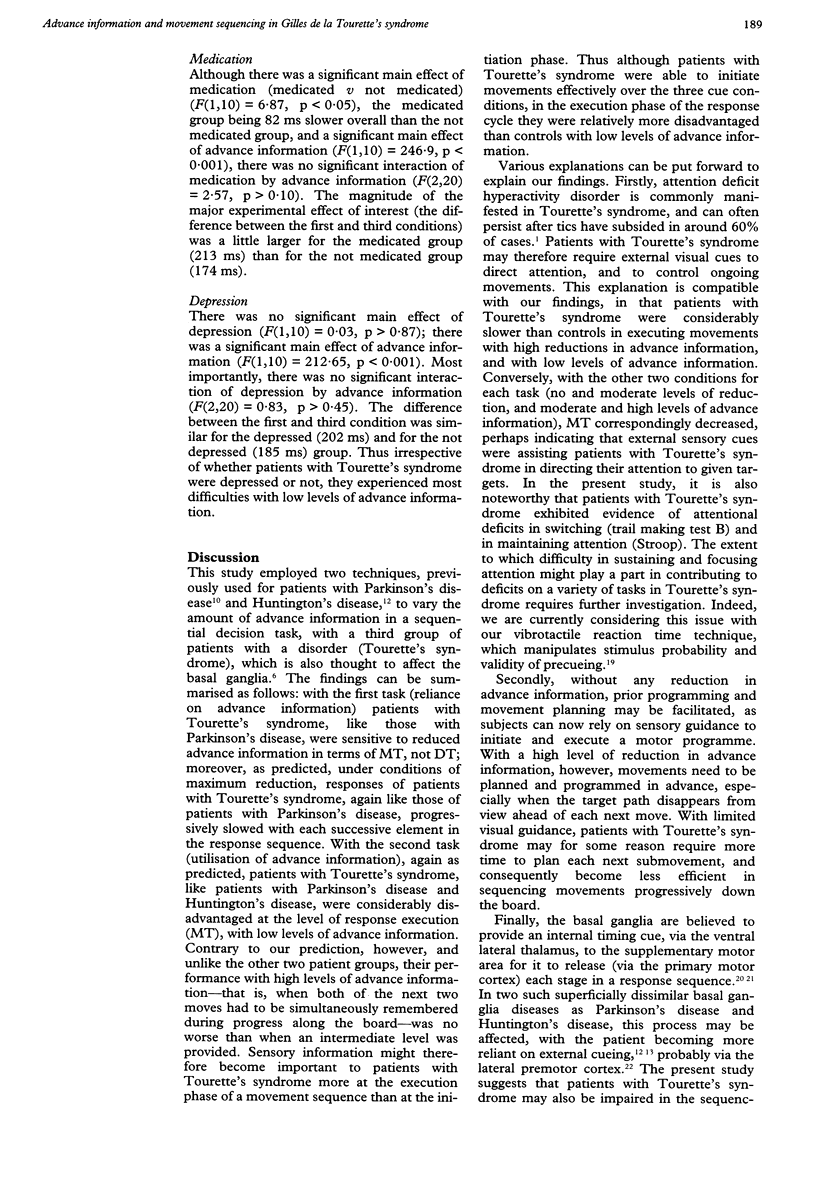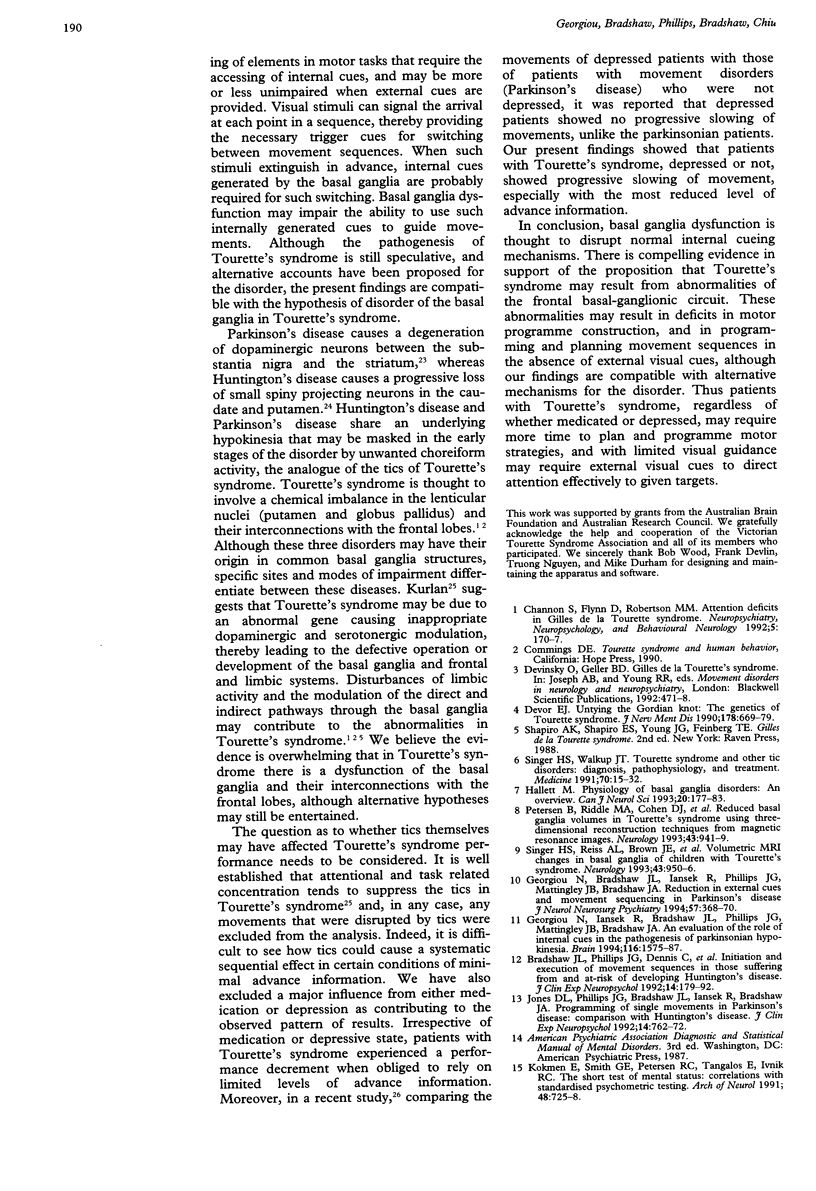Abstract
Tourette's syndrome is a chronic neurological disorder manifested by involuntary motor tics and vocalisations. Because the basal ganglia have been implicated in the pathology underlying Tourette's syndrome, the present two procedures, both involving sequential movements, sought to determine the extent to which patients with Tourette's syndrome were reliant on, and could utilise different levels of advance information. Patients with Tourette's syndrome were found to be more reliant than controls on external visual cues to execute rather than to initiate a motor programme. When there was a high level of reduction in advance information--that is, a visual pathway to be followed was extinguished well in advance of each successive movement--executions progressively slowed as the sequence was traversed. Similarly, if no advance information was provided before each move, movement execution was slower than that of controls. The movement initiation times of patients with Tourette's syndrome were, however, similar to those of controls, as were their movement execution times when advance visual information was available. It seems that patients with Tourette's syndrome, like parkinsonian patients who are known to have a basal ganglia disorder, require external sensory cues to sequence a motor programme effectively. The present study found evidence consistent with the hypothesis that patients with Tourette's syndrome, like patients with Parkinson's disease, may be dysfunctional in internal switching mechanisms. Alternatively, with limited visual guidance, patients with Tourette's syndrome, regardless of medication or depression state, may require more time to plan and programme each next submovement, and under such conditions may require external visual cues to direct attention effectively to given targets. Although the underlying pathogenesis is still speculative, it is concluded that there is much to support the notion that Tourette's syndrome may stem from abnormalities of the major pathways between the basal ganglia and the frontal lobes.
Full text
PDF







Selected References
These references are in PubMed. This may not be the complete list of references from this article.
- Bradshaw J. L., Phillips J. G., Dennis C., Mattingley J. B., Andrewes D., Chiu E., Pierson J. M., Bradshaw J. A. Initiation and execution of movement sequences in those suffering from and at-risk of developing Huntington's disease. J Clin Exp Neuropsychol. 1992 Mar;14(2):179–192. doi: 10.1080/01688639208402822. [DOI] [PubMed] [Google Scholar]
- Bradshaw J. L., Waterfall M. L., Phillips J. G., Iansek R., Mattingley J. B., Bradshaw J. A. Re-orientation of attention in Parkinson's disease: an extension to the vibrotactile modality. Neuropsychologia. 1993 Jan;31(1):51–66. doi: 10.1016/0028-3932(93)90080-j. [DOI] [PubMed] [Google Scholar]
- Brotchie P., Iansek R., Horne M. K. Motor function of the monkey globus pallidus. 1. Neuronal discharge and parameters of movement. Brain. 1991 Aug;114(Pt 4):1667–1683. doi: 10.1093/brain/114.4.1667. [DOI] [PubMed] [Google Scholar]
- Brotchie P., Iansek R., Horne M. K. Motor function of the monkey globus pallidus. 2. Cognitive aspects of movement and phasic neuronal activity. Brain. 1991 Aug;114(Pt 4):1685–1702. doi: 10.1093/brain/114.4.1685. [DOI] [PubMed] [Google Scholar]
- Devor E. J. Untying the gordian knot: the genetics of Tourette syndrome. J Nerv Ment Dis. 1990 Nov;178(11):669–679. doi: 10.1097/00005053-199011000-00001. [DOI] [PubMed] [Google Scholar]
- Fleminger S. Control of simultaneous movements distinguishes depressive motor retardation from Parkinson's disease and neuroleptic parkinsonism. Brain. 1992 Oct;115(Pt 5):1459–1480. doi: 10.1093/brain/115.5.1459. [DOI] [PubMed] [Google Scholar]
- Georgiou N., Bradshaw J. L., Iansek R., Phillips J. G., Mattingley J. B., Bradshaw J. A. Reduction in external cues and movement sequencing in Parkinson's disease. J Neurol Neurosurg Psychiatry. 1994 Mar;57(3):368–370. doi: 10.1136/jnnp.57.3.368. [DOI] [PMC free article] [PubMed] [Google Scholar]
- Georgiou N., Iansek R., Bradshaw J. L., Phillips J. G., Mattingley J. B., Bradshaw J. A. An evaluation of the role of internal cues in the pathogenesis of parkinsonian hypokinesia. Brain. 1993 Dec;116(Pt 6):1575–1587. doi: 10.1093/brain/116.6.1575. [DOI] [PubMed] [Google Scholar]
- Hallett M. Physiology of basal ganglia disorders: an overview. Can J Neurol Sci. 1993 Aug;20(3):177–183. doi: 10.1017/s0317167100047909. [DOI] [PubMed] [Google Scholar]
- Jones D. L., Phillips J. G., Bradshaw J. L., Iansek R., Bradshaw J. A. Programming of single movements in Parkinson's disease: comparison with Huntington's disease. J Clin Exp Neuropsychol. 1992 Sep;14(5):762–772. doi: 10.1080/01688639208402861. [DOI] [PubMed] [Google Scholar]
- Kokmen E., Smith G. E., Petersen R. C., Tangalos E., Ivnik R. C. The short test of mental status. Correlations with standardized psychometric testing. Arch Neurol. 1991 Jul;48(7):725–728. doi: 10.1001/archneur.1991.00530190071018. [DOI] [PubMed] [Google Scholar]
- Kurlan R. The pathogenesis of Tourette's syndrome. A possible role for hormonal and excitatory neurotransmitter influences in brain development. Arch Neurol. 1992 Aug;49(8):874–876. doi: 10.1001/archneur.1992.00530320106020. [DOI] [PubMed] [Google Scholar]
- Mushiake H., Inase M., Tanji J. Neuronal activity in the primate premotor, supplementary, and precentral motor cortex during visually guided and internally determined sequential movements. J Neurophysiol. 1991 Sep;66(3):705–718. doi: 10.1152/jn.1991.66.3.705. [DOI] [PubMed] [Google Scholar]
- Peterson B., Riddle M. A., Cohen D. J., Katz L. D., Smith J. C., Hardin M. T., Leckman J. F. Reduced basal ganglia volumes in Tourette's syndrome using three-dimensional reconstruction techniques from magnetic resonance images. Neurology. 1993 May;43(5):941–949. doi: 10.1212/wnl.43.5.941. [DOI] [PubMed] [Google Scholar]
- Schell G. R., Strick P. L. The origin of thalamic inputs to the arcuate premotor and supplementary motor areas. J Neurosci. 1984 Feb;4(2):539–560. doi: 10.1523/JNEUROSCI.04-02-00539.1984. [DOI] [PMC free article] [PubMed] [Google Scholar]
- Singer H. S., Reiss A. L., Brown J. E., Aylward E. H., Shih B., Chee E., Harris E. L., Reader M. J., Chase G. A., Bryan R. N. Volumetric MRI changes in basal ganglia of children with Tourette's syndrome. Neurology. 1993 May;43(5):950–956. doi: 10.1212/wnl.43.5.950. [DOI] [PubMed] [Google Scholar]
- Singer H. S., Walkup J. T. Tourette syndrome and other tic disorders. Diagnosis, pathophysiology, and treatment. Medicine (Baltimore) 1991 Jan;70(1):15–32. doi: 10.1097/00005792-199101000-00002. [DOI] [PubMed] [Google Scholar]
- Yesavage J. A., Brink T. L., Rose T. L., Lum O., Huang V., Adey M., Leirer V. O. Development and validation of a geriatric depression screening scale: a preliminary report. J Psychiatr Res. 1982;17(1):37–49. doi: 10.1016/0022-3956(82)90033-4. [DOI] [PubMed] [Google Scholar]


